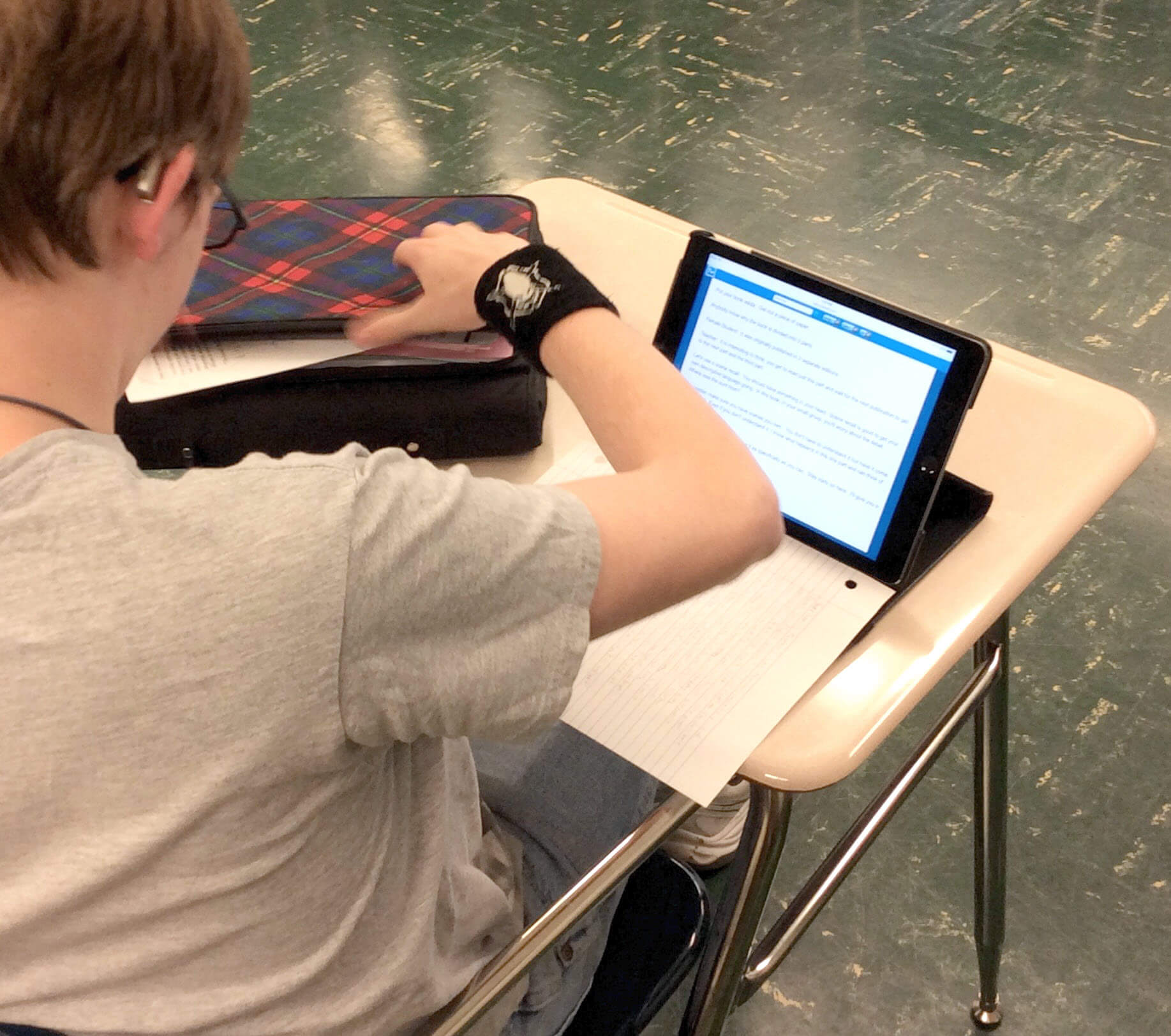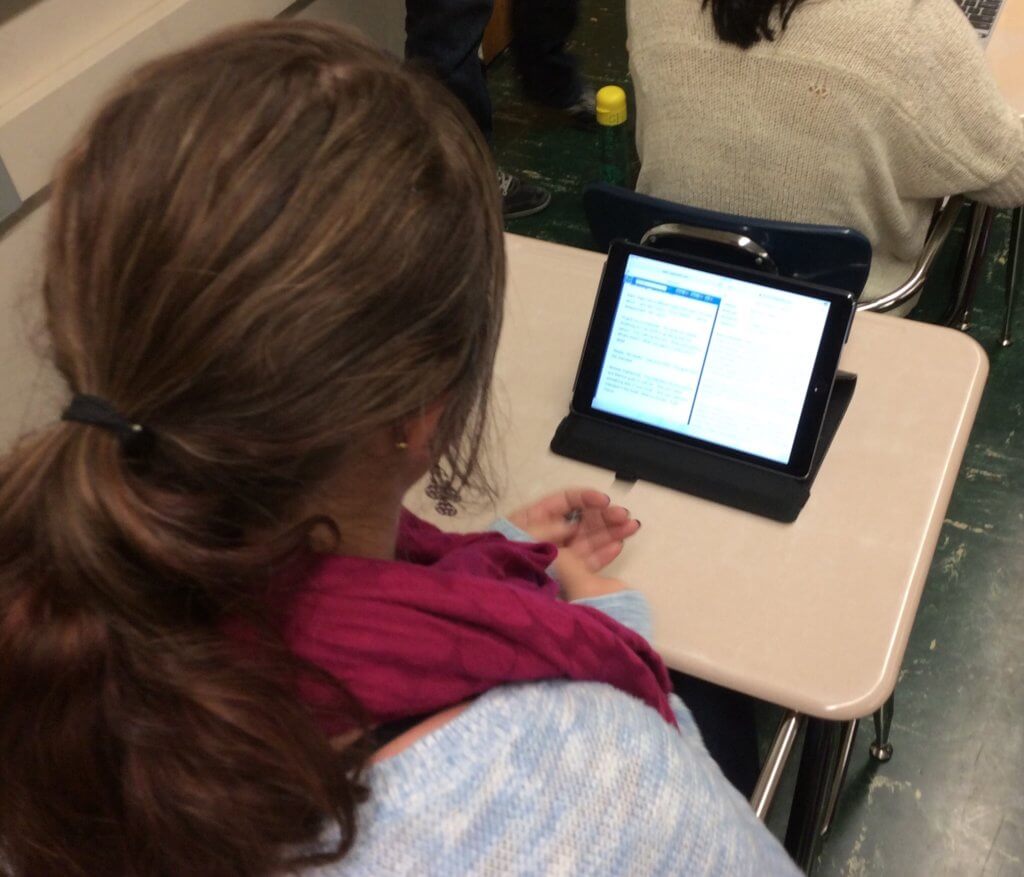
As the solo transcriber in my school district, I take the initiative to stay abreast of the latest and greatest in the world of transcription. After TypeWell released web linking, I was excited to run a parallel test with an “Indispensable iPad”, while still giving students the laptops as readers.
An Aha Moment – The Indispensable iPad!
Opening the web reader link on an iPad for the first time was one of those aha moments! No more clunky laptops getting knocked onto the floor by student backpacks, no more laptops left on desks during group work because they are too cumbersome to carry around, no more mid-day charging, and no more unreliable laptop hardware problems. Plus, there’s less weight to carry, and the iPad is so easy to use.
Knowing the school’s tight budget and lengthy ordering process, I started thinking of other ways to acquire iPads to start using right away. At one of the schools I work in, I remembered a teacher using iPads in a class. She had checked out the iPads from the school’s library, so I went to visit the librarian. The librarian was happy to check them out to me! If the library needed the iPads back, they would send me a text, and I would return them and use my laptops as backup reading devices.

Short-term solution: Check iPads out from the school library (Who knew you could do that?)
Checking iPads out from the library could be a long-term solution for some transcribers, especially if the library iPads are underused or the library has an ample supply. I used our school’s iPads for the rest of the semester (four months) without needing to return them. Since I travel to different schools, I didn’t feel comfortable checking them out from one school and using them at other schools as a long-term solution.
Long-term solution #1: Request iPads through the school budget
The first long-term solution was the traditional mindset of requesting iPads through the school budget, knowing they might not be approved. That was eight months ago, and they still have not been approved.
Long-term solution #2: Write a grant
Second, I started digging deeper for another long-term solution and ran across an article in a newsletter about an innovative grant from my district’s public school foundation. I had never written a grant before but thought, “How hard could it be?” My family has used this phrase on our sailboat for the last 20 years when we are facing a new or a tough situation on the water. Sometimes challenges can be very hard and sometimes it ends up not being a challenge at all. In the case of the grant, it wasn’t that hard!
Innovative Proposal
The first part of the grant was to explain how my proposal was innovative. I wrote five paragraphs for this section. First, I defined what transcription is. Second, I explained how transcription works in the classroom. Third, I described web linking and the usefulness of iPads and other mobile devices in the classroom. Fourth, I shared the input the students gave me after using their “Indispensable iPad.” Fifth, I presented the number of students who were impacted, and it was this paragraph which perhaps had the biggest impact on the grant’s acceptance:
“The number of students impacted by the grant is listed as 6 to 600, since there are 6 deaf and hard of hearing students that are at the academic level to use transcription, but the impact goes much further than these students by enabling them to interact more in classes with their hearing peers, share their valuable input, and access the auditory environment.”
Common Core
The second part of the grant proposal was to explain the goal and objective as it relates to Common Core standards. The standards I identified were:
- College and Career Readiness for Writing
- Use of Words and Phrases Acquired Through Conversation
- Vocabulary Acquisition and Use
- Speaking and Listening
- Spelling
- Language
Integrating iPads into the student’s day increases their use of the English language and reading efficiency, thereby strengthening their comprehension, use of vocabulary, and writing skills.
I also wrote that the deaf and hard of hearing students develop independence by utilizing the “Indispensable iPad” during class to participate in group activities. The transcripts from the classes are provided to the students to use for after-class studying. Providing deaf and hard of hearing students with real-time transcription services via iPads gives them access to the latest, easiest-to-use technological accommodations and helps prepare them for the college setting.
Get Students Involved
This grant also recommended involving students and including pictures. Each of the students I worked with was excited to be involved and wrote a paragraph on how the iPads were useful to them. I included a picture of the students using their iPads and a picture of me transcribing.
Each grant has different requirements. It’s important to review the Grant Criteria and follow the Grant Application Procedures, check off each step, and have at least two people review the grant before you submit it. Most large school districts offer a variety of grants. Search online, read school newsletters, and talk to teachers and librarians to find out about grant opportunities.
I wish you success in obtaining iPads. Please share if you find another method of acquiring them. Happy grant writing!

A TypeWell transcriber since 2013 for the Boise School District, Christine Fiechter has sailed the Bahamas with her husband and two children. She also manages a small business that outfits and rents pack goats to intrepid hikers of Idaho’s backcountry.

